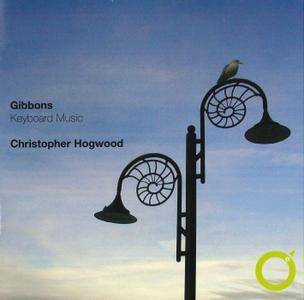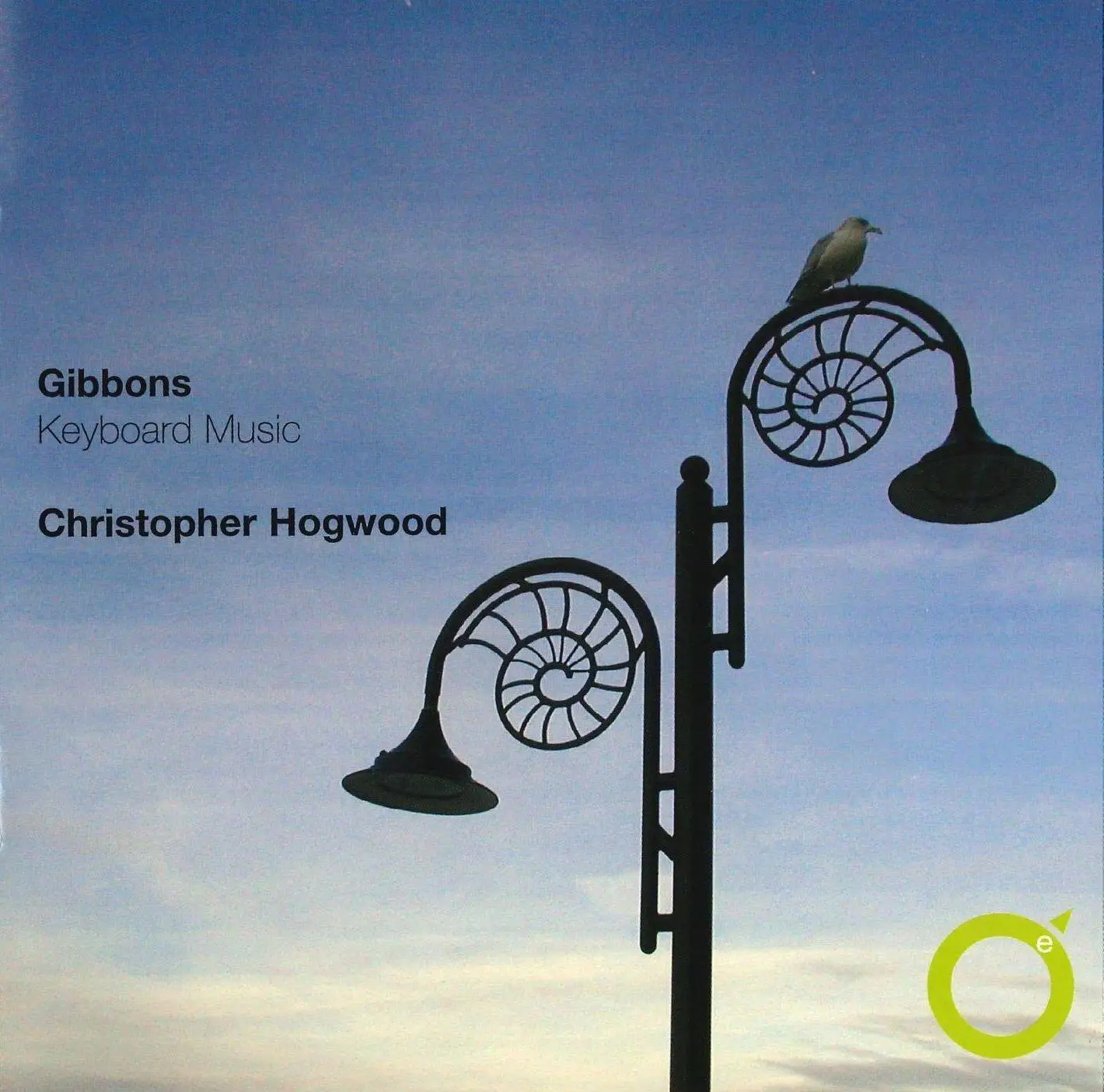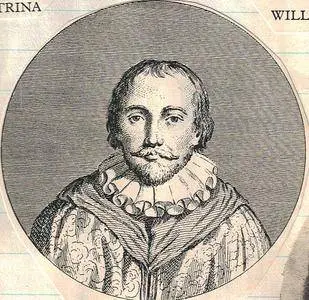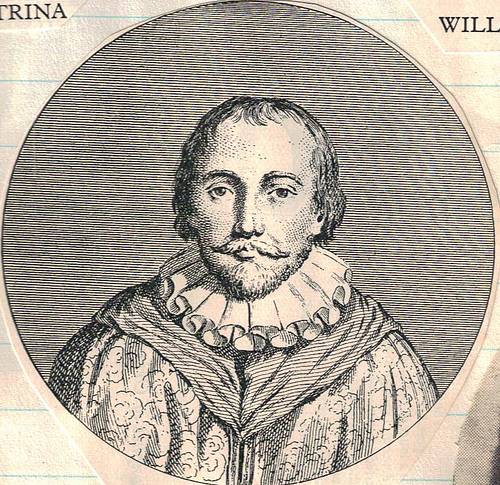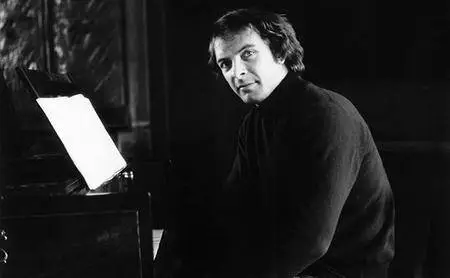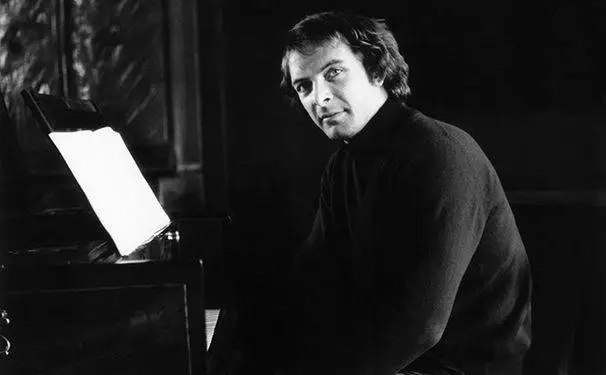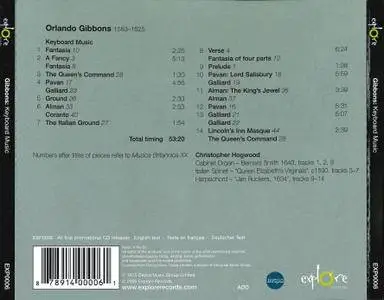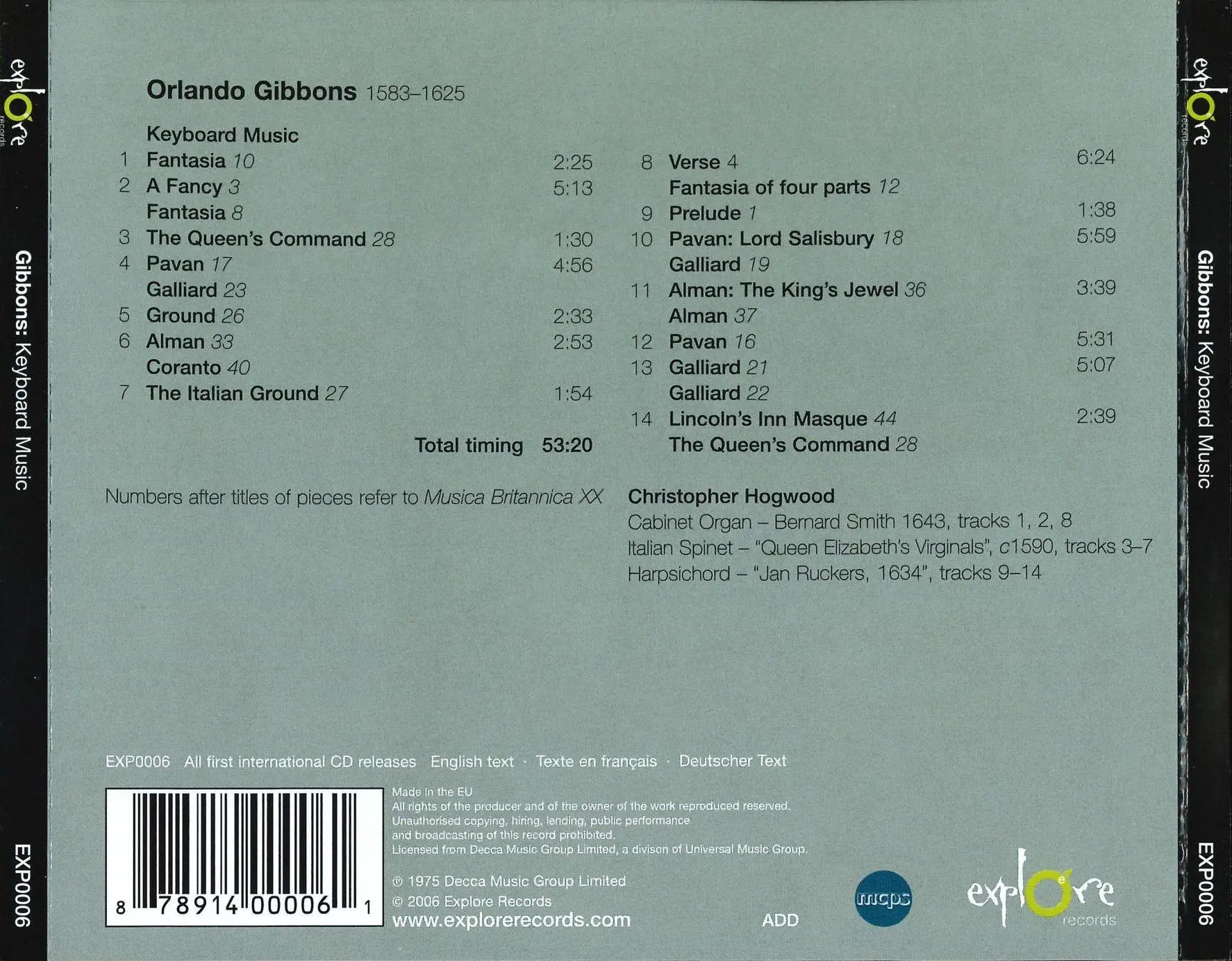Christopher Hogwood - Orlando Gibbons: Keyboard Music (1975) Reissue 2006
EAC | FLAC | Image (Cue&Log) ~ 286 Mb | Mp3 (CBR320) ~ 129 Mb | Scans included
Classical, Renaissance | Label: Explore Records | # EXP0006 | Time: 00:53:19
EAC | FLAC | Image (Cue&Log) ~ 286 Mb | Mp3 (CBR320) ~ 129 Mb | Scans included
Classical, Renaissance | Label: Explore Records | # EXP0006 | Time: 00:53:19
This is the first CD Release featuring this recording. This recording was first released on Decca's L'Oiseau-Lyre label in 1975. The CD booklet contains notes in English, French and German. Original review: “…an excellent anthology of his keyboard works… an excellent disc by any standards.” - Gramophone Magazine
The numbering in the heading refers to Musica Britannica volume 20 which contains all Gibbons’ keyboard music. This first release on CD of Christopher Hogwood’s 1975 L’Oiseau-Lyre LP features 22 pieces, about half Gibbons’ keyboard output, a representative selection of his range. Eight were first recordings (MB1, 4, 17, 22, 23, 33, 37 and 40). Since then there have been comparably dedicated CDs recorded by Richard Egarr in 1997 (Globe GLO 5168), James Johnstone in 1998 (ASV Gaudeamus CDGAU 191) and John Toll in 1999-2000 (Linn CDK 125). I shall make comparisons with these later, but Hogwood’s survey has two advantages. First, he uses restored historic instruments rather than modern copies. I personally prefer these because I feel they have the patina of maturity, though this may be ‘in the mind’. Second, Hogwood uses three instruments whereas the others use only two, so he gains more variety of tone.
Hogwood begins with a cabinet organ, a chamber variety that fits in a cabinet in a relatively domestic environment. A pity there are no photographs of the instruments featured on this CD. This one was made by Bernard Smith in 1643 and has a bright and pert tone which suits the tersely argued melodic and rhythmic thrust of the Fantasia in A minor, no. 1, MB10. The second and third parts’ imitation of the opening motif comes very quickly (tr. 1 0:05 and 0:10) so the clarity of the small organ is beneficial. Only when the structure is firmly established does Gibbons introduce flourishes of semiquaver passage-work (1:23).
The Fantasia in D minor, no. 3, MB8 (tr. 2 1:07) has a more arresting opening motif, imitated at slightly greater distance (1:12, 1:29) and more descant melodic material. It later briefly flowers forth in demisemiquaver figures (2:29) before a jauntier closing section (3:20). The Fantasia of four parts, MB12, is more ruminative in its denser texture than the usual three. This results in more audible action noise from the organ yet doesn’t mar appreciation of a piece that gradually glows more from within. Again latterly the fantasia becomes livelier (tr. 8 4:29) though Hogwood keeps it on a serene even keel.
The organ is also featured in two brief voluntaries. A Fancy, MB3 (tr. 2) is a simple, well crafted, reflective piece. Its separate timing isn’t given on the cd or therefore the heading but is 1:04. The Verse, MB4 (tr. 8), even shorter with a separate timing of 0:50, is equally uncomplicated but more inward.
Hogwood’s second instrument is an Italian spinet listed on the CD as from about 1590. This is Queen Elizabeth’s Virginals, so called because it bears her personal coat of arms. Several photographs may be viewed on the Victoria and Albert Museum website where it’s thought the instrument dates from about 1570 and was made by Benedictus Florianus of Venice. The sound comes as quite a surprise after the clean tones of the chamber organ. It’s much more petite, like the instrument, but very lithe. The Queen’s Command, not composed for its owner but another Elizabeth, James I’s daughter, is a lot of fun. A perky little tune is immediately followed by an elaborated version, a pattern followed throughout. Its second section (tr. 3 0:20) leaps merrily and its third (0:41) takes off in semiquaver runs. On this instrument it’s all gently sparkling.
The following Pavan in A minor, MB17, brings to the fore its closeness to the lute. This might be Julian Bream playing Dowland, especially given the opening reference to his Lachrymae Pavan, save that the texture, mainly in 4 parts, is more complex for this idealized dance. It’s eloquent in expression, sober in pulse and finds pathos in the gently descending sequences of the second section (0:50). The Galliard in D minor, no. 3, MB23 makes a suitable partner with its brightness of a sallow kind and a more reflective vein than most. In his scholarly but to the point booklet notes Hogwood shows how Gibbons quotes and creatively extends the tune The woods so wild in its second section.
The Ground, MB26 is elegantly melodious, ingeniously constructed with the foundation decorated and not plainly discernible until the fifth section (tr. 5 1:21) when unadorned beneath a dazzling crust of semiquaver runs. Hogwood presents it with calm assurance and the spinet scintillates. The Italian Ground is a more stolid affair, the bass firmly supporting the highjinks above. But the low tessitura much of the time makes the piece rather dour.
The Alman in D minor, MB33 is neat, clean lined and slightly wistful in Hogwood’s hands, with decorous ornamentation at the repeat of the closing cadence. The Coranto in D minor, no. 2, MB40 is more florid, the whole repeated rather than section by section, allowing more readily appreciation of its craftsmanship. And it’s good that this is done as this remains the only recording of this piece.
With the Prelude in A minor, no. 1, MB1 comes Hogwood’s third instrument, a signed Jan Ruckers harpsichord dated 1634 which may be an English fake of a later date. Whatever its origin, this is a stunning sounding instrument. Its shimmering tone comes as an impressive bolt from the blue for this toccata like virtuoso display piece. A vivid illustration why Gibbons as a performer of his own music was called ‘the best Finger of that Age’.
To ensure you catch the distinction between spinet and harpsichord Hogwood gives a second performance of The Queen’s Command, this time on harpsichord, to close the CD (tr. 14 1:10). The piece is now weightier and grander. It’s lost its joie de vivre but has gained resplendent majesty, while Hogwood’s playing is pretty breathtaking too.
The Pavan written in memory of Lord Salisbury, probably the best known and arguably finest of all, has a stately breadth and dignity. Its melodic progress seems satisfyingly inevitable but a key ingredient is the counterbalancing and often melodic role of the left hand. This is the only Pavan for which Gibbons composed a pairing Galliard, developing from a lighter variant of the same theme which takes imaginative flight. The dance origin has virtually vanished but in the repeat of the second section (tr. 10 4:40) the bass is spotlit for its character and substance.
The Pavan in G minor, MB16 is notable for its fittingly doleful derivation from Dowland’s Lachrymae Pavan at the opening, clearly illustrated in Hogwood’s booklet notes. The focus is then on embellishing the melody with figuration in sequences divided between the hands. Hogwood’s approach is that of patiently unfolding, but the particularly free flowing close of the repetition of the third section (tr. 12 4:13) has something of the effect of moving towards a Galliard.
We get two more actual Galliards. No. 1 in D minor, MB21 has a courtly melody but the interest switches in the repetitions of both sections to the lively bass. No. 2 in D minor, MB22 is inherently more flamboyant but becomes ever more so as it progresses in bravura and brilliance. Finally there are examples showcasing Gibbons’ skill in arranging familiar tunes of the day. The Alman, The King’s Jewel is very showy, the Alman in G, MB37 even more so and rather flighty with it in Hogwood’s adept treatment. Lincoln’s Inn Masque is a jaunty dance whose piping and skipping nature Hogwood demonstrates robustly.
Now for the comparisons flagged earlier. Only John Toll also partly features an organ and a historic one too, though he uses a modern harpsichord. His organ is slightly later, that of Adlington Hall, from about 1693, and a fair deal larger. But its tone is smoother, the effect more flute like and the recording airier. As Toll consistently takes a slightly more measured approach than Hogwood, this emphasises the smoothness to more meditative effect. For example in the Fantasia MB8 Toll’s timing is 4:37 against Hogwood’s 3:58. Toll’s progress is of a regal kind with assured differentiation of melody and decoration, a closing strength of deliberation and affirmation, yet using the denser tone of the larger organ with sensitivity. Hogwood is more pert, crisper, more exciting and structurally clearer, his sense of climax more internal.
In the Fantasia MB10 Hogwood similarly shows more pacy earnestness and bravura. In A Fancy, MB3 Toll is more mellifluous but Hogwood is plainer and arguably purer, less artful. A similar, calmer, more pristine quality is found in Hogwood’s Verse MB4 in comparison with the smoother Toll.
However, in the Fantasia of four parts Toll, now playing a harpsichord, is a little faster, 5:13 against Hogwood’s 5:37. Toll begins in a clear, sedate manner of patient distillation, only to become much more urgent and climactic at the point mentioned earlier when Hogwood becomes livelier. The use of organ makes for a more majestic effect, while Hogwood’s more consistent tempo brings a compelling firmness of progression.
For the Pavan MB17, I compared Richard Egarr whose timing of 4:21 looks much slower than Hogwood’s 2:49. But in fact it’s faster, being in effect 2:10 as Egarr follows the MB editor’s suggestion to repeat the sections. This also allows him further variation such as a little more ornamentation in the repeat of the first section and playing that of the final section more reflectively, as a kind of farewell. But I prefer Hogwood’s more sober, careful measure and clear exposition without the repeats which Hogwood’s booklet note strongly argues against. Egarr plays on a harpsichord in this piece which is a little denser in tone than Hogwood’s spinet. More strikingly diverse is the muselar, another mini-harpsichord like Hogwood’s spinet but of different construction, which Egarr uses for the Galliard MB23. This has a juicier, more melodious sound and the effect of Egarr’s performance is altogether daintier, even slightly chintzy. Hogwood is structurally firmer and gradually reveals more zip in this galliard, albeit decorously applied. Indeed the repeat of the final section (tr. 4 4:32) threatens to take off.
In the Pavan and Galliard Lord Salisbury I compared James Johnstone. In the Pavan Johnstone accepts the MB editor’s suggestion to repeat the sections and does so with a little tastefully additional ornamentation. He is very stately and deliberate, rather more rich than sober and at times appearing frozen in time with no will to progress, though the final section becomes more dramatic. Johnstone’s Galliard, on the other hand, is all vibrant attack and steely, aggressive scintillation, gripping but not easy to live with.
Hogwood’s Salisbury Pavan, without repeats, maintains a fine balance between dignity and the illusion of purposeful movement while the progress of the melodic line is also thereby clearer. That line is still firmly on show in a scrupulously balanced Galliard.
Johnstone brings a well judged breadth to the Pavan MB16 so it’s contemplative without being over solemn. He clearly demonstrates how the written out repetitions are ornamental versions. His fine pacing lets the melody appear to hang in the air without losing shape. Hogwood uses a softer registration, to more elegiac effect. His smoother phrasing makes for a more poetic, beautifully sorrowing progress. Egarr’s stands back and savours the Galliard MB22 in all its intricacy and ornament, lively and firmly structured. Hogwood brings more crisp immediacy and involvement while still securely revealing the structure.
Egarr’s Ground MB26 is delightful in its own way: pretty, melodious and with something of the character of a musical box. Hogwood is still lute like but with more sinewy resilience in the internal echoes of the plentiful imitative writing. Johnstone makes The Italian Ground, played on the harpsichord, stirring, knock-’em-for-six stuff. Hogwood on the spinet is more contained yet still melodically and rhythmically satisfying.
Egarr offers appreciable delicacy in the Alman MB33 but Hogwood shows a lighter, more pointed dance vivacity. Johnstone’s performance of another Alman, The King’s Jewel is forthright and enjoys the intricacy of its ornamentation but Hogwood is pacier, 2:10 against 2:46, and gloriously revels in the sheer confident take-up of the tune. In the Alman MB37 Egarr is sweetly reflective with quiet, reposeful detail. But again the pacier Hogwood, 1:29 against 2:07, finds more vivacity, albeit of a smiling, benign type.
This same contrast in pace can be observed in the Prelude MB1, where Hogwood’s 1:38 finds more nervous energy and swashbuckling excitement in comparison with Toll’s 1:55 of impressive, calm fluency but abstaining from drama.
A word on the recordings. The instruments on this Hogwood CD, in the fashion of the time, are closely recorded. This makes for great vividness of sound but neutralizing of acoustic. The other CDs provide more air around their instruments and a more natural ambience. That said, this analogue recording has scrubbed up well in its digital remastering and the sound isn’t an issue.
To sum up, this is the classic recording of Gibbons’ keyboard music with playing unsurpassed by its successors. The performances have considerable élan yet still honour the music’s essential balance. Registrations are cited for all the organ and harpsichord items. The total timing of 53:20, short measure by today’s standards, is simply that of the original LP. It’s offset by the reasonably modest price.Review by Michael Greenhalgh, MusicWeb-International.com
Christopher Hogwood (cabinet organ, Italian spinet, harpsichord)
rec. Victoria and Albert Museum, London, April 1975
Tracklist:
Orlando Gibbons (1583-1625)
01. Fantasia (2:28)
02. A Fancy - Fantasia (5:19)
03. The Queen's Command (1:33)
04. Pavan - Galliard (5:00)
05. Ground (2:37)
06. Alman - Couranto (2:57)
07. The Italian Ground (2:04)
08. Verse - Fantasia of four parts (6:28)
09. Prelude (1:42)
10. Pavan: Lord Salisbury - Galliard (6:03)
11. Alman: The King's Jewel - Alman (3:42)
12. Pavan (5:34)
13. Galliard - Galliard (5:11)
14. Lincoln's Inn Masque - The Queen's Command (2:40)
Exact Audio Copy V1.3 from 2. September 2016
EAC extraction logfile from 10. December 2017, 22:40
Christopher Hogwood / Orlando Gibbons - Keyboard Music
Used drive : PLDS DVD-RW DU8A6SH Adapter: 1 ID: 0
Read mode : Secure
Utilize accurate stream : Yes
Defeat audio cache : Yes
Make use of C2 pointers : No
Read offset correction : 6
Overread into Lead-In and Lead-Out : No
Fill up missing offset samples with silence : Yes
Delete leading and trailing silent blocks : No
Null samples used in CRC calculations : Yes
Used interface : Native Win32 interface for Win NT & 2000
Used output format : User Defined Encoder
Selected bitrate : 128 kBit/s
Quality : High
Add ID3 tag : No
Command line compressor : C:\Program Files (x86)\Exact Audio Copy\Flac\flac.exe
Additional command line options : -V -8 -T "Date=%year%" -T "Genre=%genre%" %source%
TOC of the extracted CD
Track | Start | Length | Start sector | End sector
––––––––––––––––––––––––––––-
1 | 0:00.00 | 2:28.22 | 0 | 11121
2 | 2:28.22 | 5:19.23 | 11122 | 35069
3 | 7:47.45 | 1:33.20 | 35070 | 42064
4 | 9:20.65 | 4:59.58 | 42065 | 64547
5 | 14:20.48 | 2:37.37 | 64548 | 76359
6 | 16:58.10 | 2:57.22 | 76360 | 89656
7 | 19:55.32 | 2:03.47 | 89657 | 98928
8 | 21:59.04 | 6:27.65 | 98929 | 128018
9 | 28:26.69 | 1:42.00 | 128019 | 135668
10 | 30:08.69 | 6:02.54 | 135669 | 162872
11 | 36:11.48 | 3:42.27 | 162873 | 179549
12 | 39:54.00 | 5:34.35 | 179550 | 204634
13 | 45:28.35 | 5:10.60 | 204635 | 227944
14 | 50:39.20 | 2:39.50 | 227945 | 239919
Range status and errors
Selected range
Filename C:\temp\Gibbons - Keyboard Music - Hogwood\Gibbons - Keyboard Music.wav
Peak level 55.7 %
Extraction speed 3.4 X
Range quality 100.0 %
Test CRC 9CD55C07
Copy CRC 9CD55C07
Copy OK
No errors occurred
AccurateRip summary
Track 1 accurately ripped (confidence 6) [207D8E32] (AR v2)
Track 2 accurately ripped (confidence 6) [458E9B4C] (AR v2)
Track 3 accurately ripped (confidence 6) [5DB437DE] (AR v2)
Track 4 accurately ripped (confidence 6) [766CF8CF] (AR v2)
Track 5 accurately ripped (confidence 6) [5FC8FD74] (AR v2)
Track 6 accurately ripped (confidence 6) [85BA1995] (AR v2)
Track 7 accurately ripped (confidence 6) [A3856623] (AR v2)
Track 8 accurately ripped (confidence 6) [2AE162F9] (AR v2)
Track 9 accurately ripped (confidence 6) [C2F6F9EA] (AR v2)
Track 10 accurately ripped (confidence 6) [E47B1E93] (AR v2)
Track 11 accurately ripped (confidence 6) [C5FCC16F] (AR v2)
Track 12 accurately ripped (confidence 6) [096F6D64] (AR v2)
Track 13 accurately ripped (confidence 6) [219F6BE6] (AR v2)
Track 14 accurately ripped (confidence 6) [C870883C] (AR v2)
All tracks accurately ripped
End of status report
==== Log checksum D27C9735E54146C236F26D989C2848713F399FF0FE3833516D6BD8A11886E032 ====
EAC extraction logfile from 10. December 2017, 22:40
Christopher Hogwood / Orlando Gibbons - Keyboard Music
Used drive : PLDS DVD-RW DU8A6SH Adapter: 1 ID: 0
Read mode : Secure
Utilize accurate stream : Yes
Defeat audio cache : Yes
Make use of C2 pointers : No
Read offset correction : 6
Overread into Lead-In and Lead-Out : No
Fill up missing offset samples with silence : Yes
Delete leading and trailing silent blocks : No
Null samples used in CRC calculations : Yes
Used interface : Native Win32 interface for Win NT & 2000
Used output format : User Defined Encoder
Selected bitrate : 128 kBit/s
Quality : High
Add ID3 tag : No
Command line compressor : C:\Program Files (x86)\Exact Audio Copy\Flac\flac.exe
Additional command line options : -V -8 -T "Date=%year%" -T "Genre=%genre%" %source%
TOC of the extracted CD
Track | Start | Length | Start sector | End sector
––––––––––––––––––––––––––––-
1 | 0:00.00 | 2:28.22 | 0 | 11121
2 | 2:28.22 | 5:19.23 | 11122 | 35069
3 | 7:47.45 | 1:33.20 | 35070 | 42064
4 | 9:20.65 | 4:59.58 | 42065 | 64547
5 | 14:20.48 | 2:37.37 | 64548 | 76359
6 | 16:58.10 | 2:57.22 | 76360 | 89656
7 | 19:55.32 | 2:03.47 | 89657 | 98928
8 | 21:59.04 | 6:27.65 | 98929 | 128018
9 | 28:26.69 | 1:42.00 | 128019 | 135668
10 | 30:08.69 | 6:02.54 | 135669 | 162872
11 | 36:11.48 | 3:42.27 | 162873 | 179549
12 | 39:54.00 | 5:34.35 | 179550 | 204634
13 | 45:28.35 | 5:10.60 | 204635 | 227944
14 | 50:39.20 | 2:39.50 | 227945 | 239919
Range status and errors
Selected range
Filename C:\temp\Gibbons - Keyboard Music - Hogwood\Gibbons - Keyboard Music.wav
Peak level 55.7 %
Extraction speed 3.4 X
Range quality 100.0 %
Test CRC 9CD55C07
Copy CRC 9CD55C07
Copy OK
No errors occurred
AccurateRip summary
Track 1 accurately ripped (confidence 6) [207D8E32] (AR v2)
Track 2 accurately ripped (confidence 6) [458E9B4C] (AR v2)
Track 3 accurately ripped (confidence 6) [5DB437DE] (AR v2)
Track 4 accurately ripped (confidence 6) [766CF8CF] (AR v2)
Track 5 accurately ripped (confidence 6) [5FC8FD74] (AR v2)
Track 6 accurately ripped (confidence 6) [85BA1995] (AR v2)
Track 7 accurately ripped (confidence 6) [A3856623] (AR v2)
Track 8 accurately ripped (confidence 6) [2AE162F9] (AR v2)
Track 9 accurately ripped (confidence 6) [C2F6F9EA] (AR v2)
Track 10 accurately ripped (confidence 6) [E47B1E93] (AR v2)
Track 11 accurately ripped (confidence 6) [C5FCC16F] (AR v2)
Track 12 accurately ripped (confidence 6) [096F6D64] (AR v2)
Track 13 accurately ripped (confidence 6) [219F6BE6] (AR v2)
Track 14 accurately ripped (confidence 6) [C870883C] (AR v2)
All tracks accurately ripped
End of status report
==== Log checksum D27C9735E54146C236F26D989C2848713F399FF0FE3833516D6BD8A11886E032 ====
foobar2000 1.2 / Dynamic Range Meter 1.1.1
log date: 2018-03-06 06:37:16
––––––––––––––––––––––––––––––––––––––––
Analyzed: Christopher Hogwood / Orlando Gibbons - Keyboard Music
––––––––––––––––––––––––––––––––––––––––
DR Peak RMS Duration Track
––––––––––––––––––––––––––––––––––––––––
DR10 -6.60 dB -19.66 dB 2:28 01-Fantasia
DR11 -5.08 dB -19.61 dB 5:19 02-A Fancy - Fantasia
DR13 -9.83 dB -25.05 dB 1:33 03-The Queen's Command
DR14 -10.96 dB -27.97 dB 5:00 04-Pavan - Galliard
DR14 -10.98 dB -27.31 dB 2:37 05-Ground
DR14 -10.32 dB -26.03 dB 2:57 06-Alman - Couranto
DR13 -8.71 dB -24.86 dB 2:04 07-The Italian Ground
DR11 -7.06 dB -21.64 dB 6:28 08-Verse - Fantasia of four parts
DR12 -7.94 dB -23.02 dB 1:42 09-Prelude
DR13 -7.94 dB -24.48 dB 6:03 10-Pavan: Lord Salisbury - Galliard
DR13 -7.20 dB -24.02 dB 3:42 11-Alman: The King's Jewel - Alman
DR13 -9.57 dB -26.33 dB 5:34 12-Pavan
DR13 -5.94 dB -21.91 dB 5:11 13-Galliard - Galliard
DR12 -5.25 dB -20.51 dB 2:40 14-Lincoln's Inn Masque - The Queen's Command
––––––––––––––––––––––––––––––––––––––––
Number of tracks: 14
Official DR value: DR12
Samplerate: 44100 Hz
Channels: 2
Bits per sample: 16
Bitrate: 731 kbps
Codec: FLAC
================================================================================
log date: 2018-03-06 06:37:16
––––––––––––––––––––––––––––––––––––––––
Analyzed: Christopher Hogwood / Orlando Gibbons - Keyboard Music
––––––––––––––––––––––––––––––––––––––––
DR Peak RMS Duration Track
––––––––––––––––––––––––––––––––––––––––
DR10 -6.60 dB -19.66 dB 2:28 01-Fantasia
DR11 -5.08 dB -19.61 dB 5:19 02-A Fancy - Fantasia
DR13 -9.83 dB -25.05 dB 1:33 03-The Queen's Command
DR14 -10.96 dB -27.97 dB 5:00 04-Pavan - Galliard
DR14 -10.98 dB -27.31 dB 2:37 05-Ground
DR14 -10.32 dB -26.03 dB 2:57 06-Alman - Couranto
DR13 -8.71 dB -24.86 dB 2:04 07-The Italian Ground
DR11 -7.06 dB -21.64 dB 6:28 08-Verse - Fantasia of four parts
DR12 -7.94 dB -23.02 dB 1:42 09-Prelude
DR13 -7.94 dB -24.48 dB 6:03 10-Pavan: Lord Salisbury - Galliard
DR13 -7.20 dB -24.02 dB 3:42 11-Alman: The King's Jewel - Alman
DR13 -9.57 dB -26.33 dB 5:34 12-Pavan
DR13 -5.94 dB -21.91 dB 5:11 13-Galliard - Galliard
DR12 -5.25 dB -20.51 dB 2:40 14-Lincoln's Inn Masque - The Queen's Command
––––––––––––––––––––––––––––––––––––––––
Number of tracks: 14
Official DR value: DR12
Samplerate: 44100 Hz
Channels: 2
Bits per sample: 16
Bitrate: 731 kbps
Codec: FLAC
================================================================================


